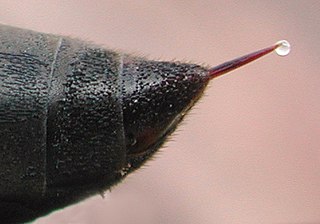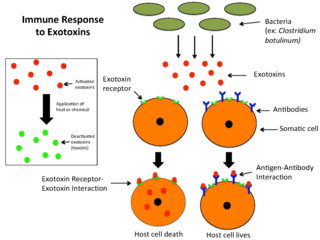Related Research Articles

γ-Hydroxybutyric acid (GHB), also known as 4-hydroxybutanoic acid is a naturally occurring neurotransmitter and a depressant drug. It is a precursor to GABA, glutamate, and glycine in certain brain areas. It acts on the GHB receptor and is a weak agonist at the GABAB receptor. GHB has been used in the medical setting as a general anesthetic and as treatment for cataplexy, narcolepsy, and alcoholism. The substance is also used illicitly for various reasons, including as a performance-enhancing drug, date rape drug, and as a recreational drug.
Language acquisition is the process by which humans acquire the capacity to perceive and comprehend language. In other words, it is how human beings gain the ability to be aware of language, to understand it, and to produce and use words and sentences to communicate.

Venom or zootoxin is a type of toxin produced by an animal that is actively delivered through a wound by means of a bite, sting, or similar action. The toxin is delivered through a specially evolved venom apparatus, such as fangs or a stinger, in a process called envenomation. Venom is often distinguished from poison, which is a toxin that is passively delivered by being ingested, inhaled, or absorbed through the skin, and toxungen, which is actively transferred to the external surface of another animal via a physical delivery mechanism.

Botulinum toxin, or botulinum neurotoxin, is a highly potent neurotoxic protein produced by the bacterium Clostridium botulinum and related species. It prevents the release of the neurotransmitter acetylcholine from axon endings at the neuromuscular junction, thus causing flaccid paralysis. The toxin causes the disease botulism. The toxin is also used commercially for medical and cosmetic purposes. Botulinum toxin is an acetylcholine release inhibitor and a neuromuscular blocking agent.

Tetanus, also known as lockjaw, is a bacterial infection caused by Clostridium tetani and characterized by muscle spasms. In the most common type, the spasms begin in the jaw, and then progress to the rest of the body. Each spasm usually lasts for a few minutes. Spasms occur frequently for three to four weeks. Some spasms may be severe enough to fracture bones. Other symptoms of tetanus may include fever, sweating, headache, trouble swallowing, high blood pressure, and a fast heart rate. Onset of symptoms is typically 3 to 21 days following infection. Recovery may take months; about 10% of cases prove to be fatal.

Sir Hans Adolf Krebs, FRS was a German-British biologist, physician and biochemist. He was a pioneer scientist in the study of cellular respiration, a biochemical process in living cells that extracts energy from food and oxygen and makes it available to drive the processes of life. He is best known for his discoveries of two important sequences of chemical reactions that take place in the cells of nearly all organisms, including humans, other than anaerobic microorganisms, namely the citric acid cycle and the urea cycle. The former, often eponymously known as the "Krebs cycle", is the sequence of metabolic reactions that allows cells of oxygen-respiring organisms to obtain far more ATP from the food they consume than anaerobic processes such as glycolysis can supply; and its discovery earned Krebs a Nobel Prize in Physiology or Medicine in 1953. With Hans Kornberg, he also discovered the glyoxylate cycle, a slight variation of the citric acid cycle found in plants, bacteria, protists, and fungi.

Tetanus toxin (TeNT) is an extremely potent neurotoxin produced by the vegetative cell of Clostridium tetani in anaerobic conditions, causing tetanus. It has no known function for clostridia in the soil environment where they are normally encountered. It is also called spasmogenic toxin, tentoxilysin, tetanospasmin, or tetanus neurotoxin. The LD50 of this toxin has been measured to be approximately 2.5–3 ng/kg, making it second only to the related botulinum toxin (LD50 2 ng/kg) as the deadliest toxin in the world. However, these tests are conducted solely on mice, which may react to the toxin differently from humans and other animals.

Neurotoxins are toxins that are destructive to nerve tissue. Neurotoxins are an extensive class of exogenous chemical neurological insults that can adversely affect function in both developing and mature nervous tissue. The term can also be used to classify endogenous compounds, which, when abnormally contacted, can prove neurologically toxic. Though neurotoxins are often neurologically destructive, their ability to specifically target neural components is important in the study of nervous systems. Common examples of neurotoxins include lead, ethanol, glutamate, nitric oxide, botulinum toxin, tetanus toxin, and tetrodotoxin. Some substances such as nitric oxide and glutamate are in fact essential for proper function of the body and only exert neurotoxic effects at excessive concentrations.

Coprolalia is involuntary swearing or the involuntary utterance of obscene words or socially inappropriate and derogatory remarks. The word comes from the Greek κόπρος, meaning "dung, feces", and λαλιά "speech", from λαλεῖν "to talk".

An exotoxin is a toxin secreted by bacteria. An exotoxin can cause damage to the host by destroying cells or disrupting normal cellular metabolism. They are highly potent and can cause major damage to the host. Exotoxins may be secreted, or, similar to endotoxins, may be released during lysis of the cell. Gram negative pathogens may secrete outer membrane vesicles containing lipopolysaccharide endotoxin and some virulence proteins in the bounding membrane along with some other toxins as intra-vesicular contents, thus adding a previously unforeseen dimension to the well-known eukaryote process of membrane vesicle trafficking, which is quite active at the host–pathogen interface.
Amusia is a musical disorder that appears mainly as a defect in processing pitch but also encompasses musical memory and recognition. Two main classifications of amusia exist: acquired amusia, which occurs as a result of brain damage, and congenital amusia, which results from a music-processing anomaly present since birth.

Clostridium tetani is a common soil bacterium and the causative agent of tetanus. Vegetative cells of Clostridium tetani are usually rod-shaped and up to 2.5 μm long, but they become enlarged and tennis racket- or drumstick-shaped when forming spores. C. tetani spores are extremely hardy and can be found globally in soil or in the gastrointestinal tract of animals. If inoculated into a wound, C. tetani can grow and produce a potent toxin, tetanospasmin, which interferes with motor neurons, causing tetanus. The toxin's action can be prevented with tetanus toxoid vaccines, which are often administered to children worldwide.
In enzymology, 3-hydroxybutyrate dehydrogenase (EC 1.1.1.30) is an enzyme that catalyzes the chemical reaction:

Hydroxycarboxylic acid receptor 2 (HCA2), also known as GPR109A and niacin receptor 1 (NIACR1), is a protein which in humans is encoded (its formation is directed) by the HCAR2 gene and in rodents by the Hcar2 gene. The human HCAR2 gene is located on the long (i.e., "q") arm of chromosome 12 at position 24.31 (notated as 12q24.31). Like the two other hydroxycarboxylic acid receptors, HCA1 and HCA3, HCA2 is a G protein-coupled receptor (GPCR) located on the surface membrane of cells. HCA2 binds and thereby is activated by D-β-hydroxybutyric acid (hereafter termed β-hydroxybutyric acid), butyric acid, and niacin (also known as nicotinic acid). β-Hydroxybutyric and butyric acids are regarded as the endogenous agents that activate HCA2. Under normal conditions, niacin's blood levels are too low to do so: it is given as a drug in high doses in order to reach levels that activate HCA2.
Veronica van Heyningen is an English geneticist who specialises in the etiology of anophthalmia as an honorary professor at University College London (UCL). She previously served as head of medical genetics at the MRC Human Genetics Unit in Edinburgh and the president of The Genetics Society. In 2014 she became president of the Galton Institute. As of 2019 she chairs the diversity committee of the Royal Society, previously chaired by Uta Frith.
Microbial toxins are toxins produced by micro-organisms, including bacteria, fungi, protozoa, dinoflagellates, and viruses. Many microbial toxins promote infection and disease by directly damaging host tissues and by disabling the immune system. Endotoxins most commonly refer to the lipopolysaccharide (LPS) or lipooligosaccharide (LOS) that are in the outer plasma membrane of Gram-negative bacteria. The botulinum toxin, which is primarily produced by Clostridium botulinum and less frequently by other Clostridium species, is the most toxic substance known in the world. However, microbial toxins also have important uses in medical science and research. Currently, new methods of detecting bacterial toxins are being developed to better isolate and understand these toxins. Potential applications of toxin research include combating microbial virulence, the development of novel anticancer drugs and other medicines, and the use of toxins as tools in neurobiology and cellular biology.
Language acquisition is a natural process in which infants and children develop proficiency in the first language or languages that they are exposed to. The process of language acquisition is varied among deaf children. Deaf children born to deaf parents are typically exposed to a sign language at birth and their language acquisition follows a typical developmental timeline. However, at least 90% of deaf children are born to hearing parents who use a spoken language at home. Hearing loss prevents many deaf children from hearing spoken language to the degree necessary for language acquisition. For many deaf children, language acquisition is delayed until the time that they are exposed to a sign language or until they begin using amplification devices such as hearing aids or cochlear implants. Deaf children who experience delayed language acquisition, sometimes called language deprivation, are at risk for lower language and cognitive outcomes. However, profoundly deaf children who receive cochlear implants and auditory habilitation early in life often achieve expressive and receptive language skills within the norms of their hearing peers; age at implantation is strongly and positively correlated with speech recognition ability. Early access to language through signed language or technology have both been shown to prepare children who are deaf to achieve fluency in literacy skills.
Language deprivation in deaf and hard-of-hearing children is a delay in language development that occurs when sufficient exposure to language, spoken or signed, is not provided in the first few years of a deaf or hard of hearing child's life, often called the critical or sensitive period. Early intervention, parental involvement, and other resources all work to prevent language deprivation. Children who experience limited access to language—spoken or signed—may not develop the necessary skills to successfully assimilate into the academic learning environment. There are various educational approaches for teaching deaf and hard of hearing individuals. Decisions about language instruction is dependent upon a number of factors including extent of hearing loss, availability of programs, and family dynamics.
Kerstin Krieglstein is a German neuroscientist. She is the head of the University of Freiburg since 2020, after serving in the same position at the University of Konstanz from 2018 to 2020.
Bernhard "Hardi" Cinader was a Canadian Immunologist and Professor in the Department of Immunology at the University of Toronto. He was inaugural president of the Canadian Society for Immunology (1966-1969) and the International Union of Immunological Societies (1969-1974).
References
- ↑ Perring, Franklyn (11 January 1994). "Obituary: Kenneth Mellanby". The Independent. Retrieved 8 December 2021.
- ↑ Mellanby, Helen (6 December 2012). Animal Life in Fresh Water: A Guide to Fresh-Water Invertebrates. Springer Science & Business Media. ISBN 978-94-009-5849-4.
- ↑ Mellanby, Jane (2002). "Agnes Helen Neilson Mellanby". BMJ: British Medical Journal. 325 (7367): 780. doi:10.1136/bmj.325.7367.780. ISSN 0959-8138. JSTOR 25452530. PMC 1124292 . S2CID 72150556.
- 1 2 "Professor Jane Mellanby obituary". The Times. 2 April 2021. ISSN 0140-0460 . Retrieved 8 December 2021.
- ↑ Oates, Tim (9 March 2021). "Professor Jane Mellanby 1938 - 2021". Cambridge Assessment. Retrieved 8 December 2021.
- ↑ "Our Emeritus Fellow Dr Jane Mellanby, Hon FRCP, has died". St Hilda's College Oxford. 10 February 2021. Archived from the original on 8 May 2021. Retrieved 8 December 2021.
- ↑ McIntyre, Dan (25 August 2020). History of English: A Resource Book for Students. Routledge. ISBN 978-1-000-29840-6.
- ↑ “Academic Calls for More Complex Grammar on the Curriculum.” Education Journal, no. 376 (May 28, 2019): 11.
- ↑ "Jane Mellanby". Oxford Neuroscience. Retrieved 8 December 2021.
- 1 2 3 4 Mellanby, Jane; Martin, Maryanne; O'Doherty, John (August 2000). "The 'gender gap' in final examination results at Oxford University". British Journal of Psychology. 91 (3): 377–390. doi:10.1348/000712600161880. PMID 10958580.
- 1 2 Mellanby, Jane; Van Heyningen, W. E. (July 1964). "Specific Precocious Protective Action of Toxoids". Nature. 203 (4942): 312–313. Bibcode:1964Natur.203..312M. doi:10.1038/203312b0. ISSN 1476-4687. PMID 14201781. S2CID 4263260.
- 1 2 Mellanby, Jane; Green, Jane (1 March 1981). "How does tetanus toxin act?". Neuroscience. 6 (3): 281–300. doi:10.1016/0306-4522(81)90123-8. ISSN 0306-4522. PMID 6164010. S2CID 40189011.
- 1 2 Mellanby, Jane; Thompson, P. A. (1972). "The effect of tetanus toxin at the neuromuscular junction in the goldfish". The Journal of Physiology. 224 (2): 407–419. doi:10.1113/jphysiol.1972.sp009902. ISSN 1469-7793. PMC 1331497 . PMID 4341938.
- 1 2 Edwards, Lindsey; Figueras, Berta; Mellanby, Jane; Langdon, Dawn (1 March 2011). "Verbal and Spatial Analogical Reasoning in Deaf and Hearing Children: The Role of Grammar and Vocabulary". The Journal of Deaf Studies and Deaf Education. 16 (2): 189–197. doi: 10.1093/deafed/enq051 . ISSN 1081-4159. PMID 21068179.
- 1 2 Mellanby, Jane; Zimdars, Anna (1 April 2011). "Trait anxiety and final degree performance at the University of Oxford". Higher Education. 61 (4): 357–370. doi:10.1007/s10734-010-9335-5. ISSN 1573-174X. S2CID 55091360.
- 1 2 Williamson, DH; Mellanby, Jane; Krebs, Hans A (1 January 1962). "Enzymic determination of d(−)-β-hydroxybutyric acid and acetoacetic acid in blood". Biochemical Journal. 82 (1): 90–96. doi:10.1042/bj0820090. ISSN 0006-2936. PMC 1243411 . PMID 14007241.
- 1 2 Svirko, Elena; Mellanby, Jane (1 January 2008). "Attitudes to e-learning, learning style and achievement in learning neuroanatomy by medical students". Medical Teacher. 30 (9–10): e219–e227. doi:10.1080/01421590802334275. hdl: 10818/34451 . ISSN 0142-159X. PMID 19117218. S2CID 29322273.
- ↑ Krebs, HA; Mellanby, J; Williamson, DH (1 January 1962). "The equilibrium constant of the β-hydroxybutyric-dehydrogenase system". Biochemical Journal. 82 (1): 96–98. doi:10.1042/bj0820096. ISSN 0006-2936. PMC 1243412 . PMID 14459507.
- ↑ Diamond, J.; Mellanby, Jane (1971). "The effect of tetanus toxin in the goldfish". The Journal of Physiology. 215 (3): 727–741. doi:10.1113/jphysiol.1971.sp009494. ISSN 1469-7793. PMC 1331910 . PMID 4326308.
- ↑ van Heyningen, W. E.; Mellanby, Jane (1 September 1973). "A note on the specific fixation, specific deactivation and non-specific inactivation of bacterial toxins by gangliosides". Naunyn-Schmiedeberg's Archives of Pharmacology. 276 (3): 297–302. doi:10.1007/BF00499883. ISSN 1432-1912. PMID 4351284. S2CID 20359190.
- ↑ Williamson, Dermot H.; Mellanby, Jane (1 January 1974), Bergmeyer, Hans Ulrich (ed.), "D-(–)-3-Hydroxybutyrate", Methods of Enzymatic Analysis (Second Edition), Academic Press, pp. 1836–1839, doi:10.1016/b978-0-12-091304-6.50037-9, ISBN 978-0-12-091304-6 , retrieved 8 December 2021
- ↑ Nicholls, Briony; Mellanby, Jane; Smith, Stephen (1 January 1994). "The effect of Ro 15-4513, an inverse agonist at the benzodiazepine receptor, on the exploratory response to novelty in the playground maze". Journal of Psychopharmacology. 8 (1): 32–39. doi:10.1177/026988119400800106. ISSN 0269-8811. PMID 22298478. S2CID 29600493.
- ↑ Mellanby, Jane; Cortina-Borja, Mario; Stein, John (1 May 2009). "Deep learning questions can help selection of high ability candidates for universities". Higher Education. 57 (5): 597–608. doi:10.1007/s10734-008-9164-y. ISSN 1573-174X. S2CID 143958019.
- ↑ Mellanby, Jane (2014). Education and learning : an evidence-based approach. Katy Theobald (1 ed.). Chichester, West Sussex. ISBN 978-1-118-72808-6. OCLC 871820895.
{{cite book}}: CS1 maint: location missing publisher (link) - ↑ Svirko, Elena; Mellanby, Jane (November 2017). "Teaching neuroanatomy using computer-aided learning: What makes for successful outcomes?: Computer-Aided Teaching of Neuroanatomy". Anatomical Sciences Education. 10 (6): 560–569. doi:10.1002/ase.1694. PMID 28431201. S2CID 23207484.
- ↑ "Oliver Impey". The Telegraph. 31 October 2005. Retrieved 8 December 2021.